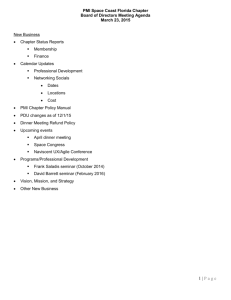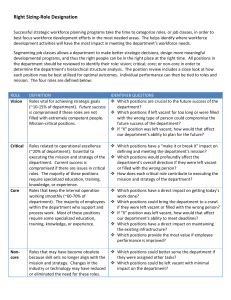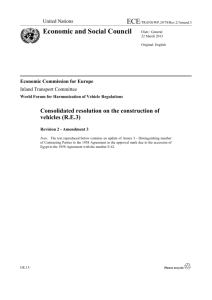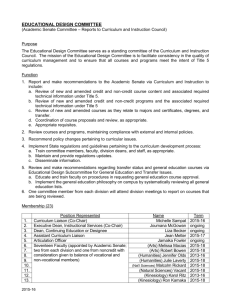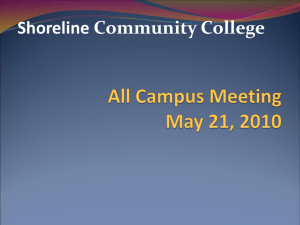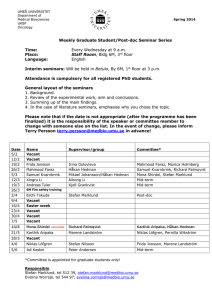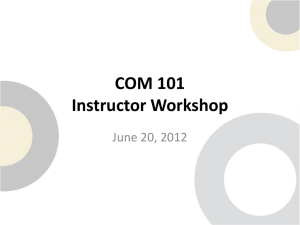Creative Preservation with Residents in Place
advertisement
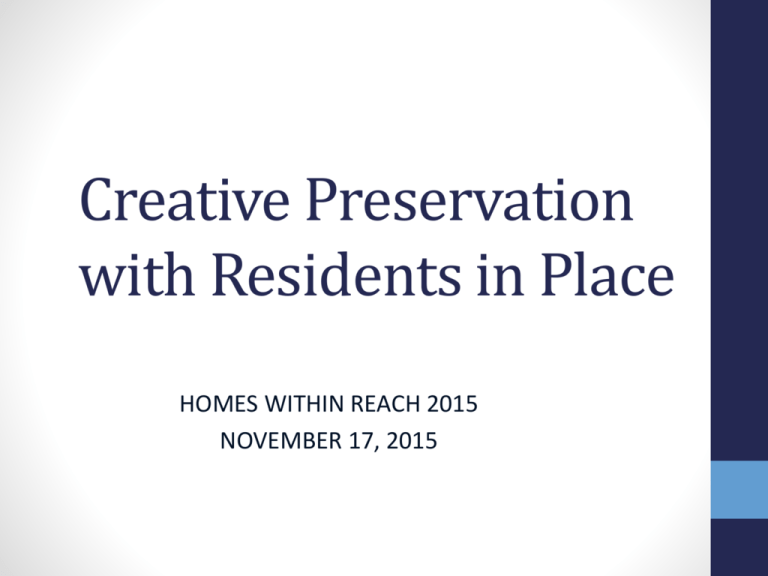
Creative Preservation with Residents in Place HOMES WITHIN REACH 2015 NOVEMBER 17, 2015 Creative Preservation with Residents in Place OTHERWISE KNOWN AS TRIALS AND TRIBULATIONS OF OCCUPIED REHAB!!! Occupied rehab issues to be discussed in today’s program, most often arise when a tenant occupied residential property is acquired by a new entity with the intent of rehab to the property, and the funds to develop the property are generated through an investment of LIHTC Creative Preservation with Residents in Place • Four staffing groups critical to the success of an acquisition/rehab (preservation) transaction Development/ Finance (Developer, Development Consultant Accountant, Attorney) • Property Management (Property Manager, Maintenance Staff) • Construction (Contractor, Architect) • Relocation (Relocation Specialist) (if applicable) • Other important team members • Investor who understands acq/rehab issues Creative Preservation with Residents in Place Goals of the Development Team- To protect the developer’s ability to maximize tax credit delivery, while causing the least disruption to the existing residents. Creative Preservation with Residents in Place Contractor – Planning for Construction is critical • SCOPE DEVELOPMENT • Capital needs assessment • Design team input • PROJECT PLANNING • • • • Scope of construction rehab Resident impact Schedule for construction Schedule for relocation Creative Preservation with Residents in Place Contractor – Scope Development • Capital Needs Assessment (CNA, PNA, PCA, RPCA) • 30 more years! • Critical, near-term, long-term repair items • All components including site conditions • Budget • Reserve analysis • Energy Audit • Scope to reduce energy costs • Modeling and utility analysis • Savings-to-investment ratio & payback period Creative Preservation with Residents in Place Contractor – Scope Development • Design team input • Owner, management, maintenance, residents, investors • Address maintainability, operability, comfort, health • Design professional coordination • Exploratory demolition • Subcontractor feedback • Code inspector input • Budget constraints • Documentation Creative Preservation with Residents in Place Contractor – Project Planning • Scope of rehab • Is relocation necessary? • Hospitality suites? • Resident impact • How will this disruption/relocation affect seniors, persons with disabilities, young children etc.? • Schedule for relocation • Temporary relocation, permanent relocation, unit vacancies • Problems with multiple buildings • Schedule for construction • Must work hand-in-hand with relocation schedule • Understand how meeting deadlines affect residents Creative Preservation with Residents in Place Project Planning – Sample Relocation Schedule No work yet Currently being renovated Renovated, being used for temporary relocation Renovated, has permanant residents in place Vacant, under construction Current Status Move 1: Construction Period 1 Clus # of Current Tenant # of HH ter Unit BR (size needed) Members 1524B 1526B 1528B 1530B 3 3 3 3 Lundy- Brabham (2) 0 5 0 2 1524B 1526B 1528B 1530B 3 3 3 3 Vacant Vacant Vacant Vacant 1516B 1518B 1520B 1522B 3 3 2 2 Vacant Daniels (3) Cromwell (2) Bolvin (2) 0 4 2 2 1516B 1518B 1520B 1522B 3 3 2 2 Darby (3) Daniels (3) Cromwell (2) #3 1508B 1510B 1512B 1514B 1 1 3 3 Young (1) Parsons (1) Smalls (2) Henry (3) 1 1 2 4 1508B 1510B 1512B 1514B 1 1 3 3 #4 1500B 1502B 1504B 1506B 2 2 1 1 Green (2) Vacant Poland (1) Haynes (1) 3 0 1 1 1500B 1502B 1504B 1506B 2 2 1 1 1508S 1510S 1512S 1514S 2 2 2 2 Jackson (2) Burgess (2) Griffin (2) McClain (2) 4 2 2 2 1508S 1510S 1512S 1514S 1516S 1518S #6 1520S 1522S 2 2 3 3 Coleman (2) White (1) Muniz (3) Allen (3) 2 1 3 4 1524S 1526S 1528S 1530S 3 3 3 3 Vacant Ryant (3) Donald (3) Vacant 0 4 4 0 #1 #2 #5 #7 Vacant Darby (3) Vacant Unit Construction Period 2 Move 2: # of Current Tenant # of HH BR (size needed) Members Unit Daniels (3) Darby (3) Smalls (2) Construction Period 3 Move 3: Current Tenant # of HH # of BR (size needed) Members 4 5 2 2 Unit # of BR 1524B 1526B 1528B 1530B 3 3 3 3 1524B 1526B 1528B 1530B 3 3 3 3 Lundy- Brabham (2) Lundy- Brabham (2) 5 4 2 2 1516B 1518B 1520B 1522B 3 3 2 2 Vacant Vacant Vacant Vacant 1516B 1518B 1520B 1522B Parsons (1) Smalls (2) Henry (3) 1 2 4 1508B 1510B 1512B 1514B 1 1 3 3 Vacant Vacant Vacant Vacant Green (2) Bolvin (2) 3 2 Haynes (1) 1 1500B 1502B 1504B 1506B 2 2 1 1 Green (2) Bolvin (2) Parsons (1) Haynes (1) 2 2 2 2 Jackson (2) Burgess (2) Griffin (2) McClain (2) 4 2 2 2 1508S 1510S 1512S 1514S 2 2 2 2 Jackson (2) Burgess (2) Griffin (2) McClain (2) 1516S 1518S 1520S 1522S 2 2 3 3 Coleman (2) White (1) Muniz (3) Allen (3) 2 1 3 4 1516S 1518S 1520S 1522S 2 2 3 3 Vacant White (1) Muniz (3) Allen (3) 1524S 1526S 1528S 1530S 3 3 3 3 Vacant Vacant Vacant Vacant 1524S 1526S 1528S 1530S Daniels (3) Darby (3) Smalls (2) Construction Period 4 Move 4 Current Tenant # of HH (size needed) Members Unit Final Move Current Tenant # of HH # of BR (size needed) Members # of BR 1524B 1526B 1528B 1530B 3 3 3 3 Lundy- Brabham (2) 4 5 2 2 Lundy- Brabham (2) 4 5 2 2 1524B 1526B 1528B 1530B 3 3 3 3 Lundy- Brabham (2) 4 5 2 2 3 3 2 2 Burgess (2) Muniz (3) White (1) McClain (2) 2 3 1 2 1516B 1518B 1520B 1522B 3 3 2 2 Burgess (2) Muniz (3) White (1) Bolvin (2) 2 3 1 2 1516B 1518B 1520B 1522B 3 3 2 2 Vacant Vacant White (1) Bolvin (2) 1 2 1508B 1510B 1512B 1514B 1 1 3 3 Haynes (1) Parsons (1) Griffin (2) Jackson (2) 1 1 2 4 1508B 1510B 1512B 1514B 1 1 3 3 Haynes (1) Parsons (1) Griffin (2) Jackson (2) 1 1 2 4 1508B 1510B 1512B 1514B 1 1 3 3 Haynes (1) Parsons (1) Griffin (2) Jackson (2) 1 1 2 4 3 2 1 1 1500B 1502B 1504B 1506B 2 2 1 1 Green (2) Bolvin (2) Vacant Vacant 3 2 1 1 1500B 1502B 1504B 1506B 2 2 1 1 Vacant Vacant Vacant Vacant 1500B 1502B 1504B 1506B 2 2 1 1 Green (2) Vacant Burgess (2) Vacant 3 4 2 2 2 1508S 1510S 1512S 1514S 2 2 2 2 Vacant Vacant Vacant Vacant 1508S 1510S 1512S 1514S 2 2 2 2 Vacant Vacant Vacant McClain (2) 1508S 1510S 1512S 1514S 2 2 2 2 Vacant Vacant Vacant McClain (2) 1 3 4 1516S 1518S 1520S 1522S 2 2 3 3 Vacant Vacant Vacant Vacant 1516S 1518S 1520S 1522S 2 2 3 3 Green (2) Vacant Vacant Vacant 1516S 1518S 1520S 1522S 2 2 3 3 Vacant Vacant Muniz (3) Vacant 3 Henry (3) 4 3 Cromwell (2) 2 3 Donald (Mt. Vernon) 5 3 Vacant 1524S 1526S 1528S 1530S 3 Henry (3) 3 Cromwell (2) 3 Donald (Mt. Vernon) 3 Allen (3) 1524S 1526S 1528S 1530S 3 Henry (3) 3 Cromwell (2) 3 Donald (Mt. Vernon) 3 Allen (3) 1524S 1526S 1528S 1530S 3 Henry (3) 3 Cromwell (2) 3 Donald (Mt. Vernon) 3 Allen (3) 4 2 5 4 Daniels (3) Darby (3) Smalls (2) Current Tenant # of HH (size needed) Members Unit 2 3 4 2 5 4 Daniels (3) Darby (3) Smalls (2) 2 2 3 4 2 5 4 Creative Preservation with Residents in Place Property Manager – Planning in advance of construction • Meet with Tenants –Information is key. Address tenant concerns about rehab, relocation, etc. • Tenant Income Certification-Advise tenants of need for income certification. • Will tenants need to relocate during construction, and if so, is the project subject to the Uniform Relocation Act? • Date of acquisition – Important that the property manager be advised of the date of acquisition of the property by the new tax credit partnership. Date of acquisition is the TIC effective date for all tenants currently residing in the property. • Property Manager has 120 days from date of acquisition to complete income certification. So long as certification is completed within this 120 day period tenants are protected by the IRS Safe Harbor set forth in IRS Rev. Procedure 2003-82. Creative Preservation with Residents in Place IRS Rev. Proc. 2003-82 Provides a safe harbor for tenants (allows them to reside in the property) when the following occurs (example) • The owner (new LP) acquires the property On October 15, 2015 • The first credit year for the project is planned for 2016. • Tenant household is income qualified in August , 2015 (total household income is below the applicable income limit) • Tenant household is retested for income in March, 2016 and it s income now exceeds the applicable income limit . Safe harbor rule allows the tenant household to remain income qualified. Creative Preservation with Residents in Place IRS 8823 Audit Guide , Chapter 4 Tenants who reside in a project governed by a LIHTC extended use agreement, and who were determined to be income qualified by the previous owner (ex. Hyatt Development Company) during that owner’s 15 year compliance period and whom remained compliant, are concurrently determined to be recognized income qualified household during the extended use period. Therefore any household determined to be income qualified at the time of move-in for purposes of the extended use agreement, is a qualified low-income household for any subsequent allocation of tax credits . Creative Preservation with Residents in Place HUD Assisted Households –HUD Memo of January 12, 2015 Occupancy Protections for HUD-Assisted Households in Properties with Low-Income Housing tax Credits • Memo provides guidance on tenancy protections for households when the project owner participates in both a HUD assisted program (e.g. PBV, Section 236, Section 202 etc.) and is now (upon acquisition by the LP), also participating in the LIHTC program. • Tenant households occupancy may not be terminated because household income exceeds tax credit limits. • Project owner may only terminate occupancy as prescribed by HUD regulations and state/local law and procedure • Owner may provide incentives to over income household to relocate but Owner must make clear to the tenant household, that the tenant has the right to continue occupying the unit. Creative Preservation with Residents in Place Investor – Issues to consider in advance of closing on acquisition and commencement of construction • Developer/Sponsor ‘s lack of experience. (Other members of the development team need to compensate by being experienced with occupied/ acquisition rehab issues. ) • Review and approve the scope of construction for long term viability • What if any existing debt is being assumed by the acquiring partnership? • Terms of this debt • When does this debt come due • What approvals are needed and by whom to allow for the assumption of debt by the acquiring partnership • Does any of this debt need to be amortized or paid out of cash flow during the upcoming tax credit compliance period • What if any regulatory agreements affect the project ? Is there an existing deed restriction, regulatory agreement or LIHTC extended use agreement for the project? Creative Preservation with Residents in Place Investor – Issues to consider in advance of closing on acquisition and commencement of construction • Determine first year of tax credit delivery • Determine tax credit delivery schedule for each building in the project (Summit Apartments has 4 building, each with a separate BIN). Need assurances from, developer, contractor and property manager that credit delivery will be timely. • Confirm what reserves, if any are being transferred with the transfer of ownership of the project. • Determine what reserves are necessary for the operation of the project. • Determine operating expenses post rehabilitation. (Assumption is that costs should go down). How much should the investor rely on past operation expenses versus projected post rehab expenses. Creative Preservation with Residents in Place Contractor-Construction Related issues • Temporary Protection- Contractor needs to protect residents from construction hazards and protect contractors from resident hazards. Be aware of possible conflicts between residents and construction crew, report all incidences to the developer and general contractor. • Communication –Communication-Communication- Between (i) the contractor and property manager and maintenance staff (ii) contractor and residents (iii) property manager and residents. Communication must be timely, routine and thorough. • Scope Changes-Unforeseen conditions are common in existing buildings. Impact on these scope changes may affect how long a resident is removed from his/her home. • Punchlisting and Acceptance of Work -Must be done prior to tenant returning to the unit. This requires coordinating time between the architect, contractor ,property manager and owner. • Post Construction-Training for residents, maintenance staff and property managers on new systems, thermostats etc. Creative Preservation with Residents in Place Property Manager- issues for occupying units post construction • Tracking Unit Qualifications for Purposes of Credit Delivery . This is a very complex issue , especially where there is more than one building to be delivered and households are moving between buildings either temporarily or on a permanent basis. • Basic Rule- If an income qualified household is out of the unit for even one day because the unit is “not suited for occupancy,” that unit cannot deliver credits for that month. • IRS 8823 Audit Guide Chapter 4 -28, provides a good example of units that can and cannot be counted as tax credit eligible during rehab and the first year of credit delivery. Creative Preservation with Residents in Place Sum Up: Acquisition rehab (occupied rehab) is complex and requires careful planning and skilled and timely execution. Make sure the development team is experienced and understands the issues, and what is at stake for the developer, owner, investor and most importantly, the residents of the project . Creative Preservation with Residents in Place Thank you for your attendance from: Dina Schlossberg, Regional Housing Legal Services dina.schlossberg@rhls.org Julia Blackett, Consultant jjjbbcg@gmail.com Vaughan Piccolo , Innova Services Corporation vpiccolo@innovaservices.com Bryan Kilbane, Redstone Equity bryan.kilbane@RedstoneEquity.com Chris McNerney, Multifamily Management Services cmcnerney@multifamilymgt.com QUESTIONS?
